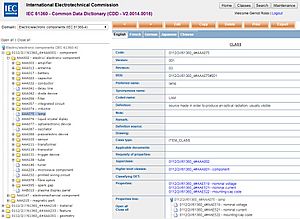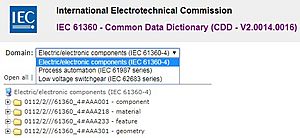IEC Common Data Dictionary facts for kids
The IEC Common Data Dictionary (or IEC CDD for short) is like a special online dictionary for products. It helps people and machines understand each other when talking about different items. Imagine a huge database that lists products and describes them in a very clear, official way. This is super useful for modern factories and industries that use smart technology, often called smart manufacturing or Industrie 4.0.
Contents
What is the IEC CDD?
The IEC CDD is a special kind of database. It helps organize and describe products using clear, agreed-upon rules. Think of it as a universal language for product information. This means that when different companies or machines talk about a product, they all use the same definitions.
This dictionary is so important that it's considered an International Standard. It even has its own standard number: IEC 61360-4 DB. This means that all the information stored in it is officially recognized around the world.
How Does it Work?
The IEC CDD is like a big rulebook for describing products. It makes sure that everyone uses the same words and definitions. For example, if you're talking about a "light bulb," the dictionary makes sure that everyone knows exactly what kind of light bulb you mean. This helps avoid confusion, especially when machines need to understand each other.
The dictionary helps organize products into different groups, like a library organizes books. Each product and its features are described in detail. For instance, a light bulb might have features like "brightness" or "power." The dictionary defines what these terms mean and what kind of values they can have (like "100 watts" for power).
Why is the IEC CDD Used?
The IEC CDD was first made to help with sharing digital information, especially for online shopping and business. Imagine buying parts from a different country. If everyone uses the same descriptions, it's much easier to know exactly what you're getting.
Today, the IEC CDD is even more important for smart manufacturing and Industrie 4.0. In these advanced factories, machines often need to talk to each other. They exchange information about products, parts, and processes. The IEC CDD helps these machines understand the meaning of the data they share.
For example, if one machine tells another that a part has a "length" of "50," the IEC CDD can tell them that "length" means a specific measurement and "50" means 50 millimeters, not 50 inches. This clear communication helps different machines from different companies work together smoothly.
What Kind of Information Does it Store?
The IEC CDD stores many types of information about products. It's all based on a set of rules called IEC 61360. Here are some examples of what you can find in the dictionary:
- Unique Names: Every product type and its features have a special, unique name.
- Values and Lists: It defines what kind of values a feature can have. For example, a "color" feature might have a list of possible values like "red," "blue," or "green."
- Official Definitions: All terms and descriptions are based on accepted international standards.
- Technical Details: It includes information like units of measurement (e.g., meters, kilograms) and data types (e.g., numbers, text).
This detailed information helps create clear descriptions for products in online catalogs or for business-to-business (B2B) communication. This is when one company sells things to another company.
What Products are in the IEC CDD?
The IEC CDD holds descriptions for many different kinds of products. These descriptions are based on various international standards. Some of the product types you can find include:
- Equipment used in process automation (like machines that control factories).
- Low voltage electrical gear (like switches and controls).
- Electro-electronic parts (like tiny components inside your phone).
- Optics (things related to light and lenses).
- Measuring instruments (tools that measure things).
- Information for environmental declarations (details about a product's environmental impact).
The IEC CDD is organized into different sections, called "domains." Each domain focuses on a specific type of product. You can usually access these domains directly through the IEC CDD website.
The dictionary also stores information about UNITS for MEASUREMENT (like meters, seconds, or degrees). These units are very important because they help make sure everyone understands the exact size or amount of something.



